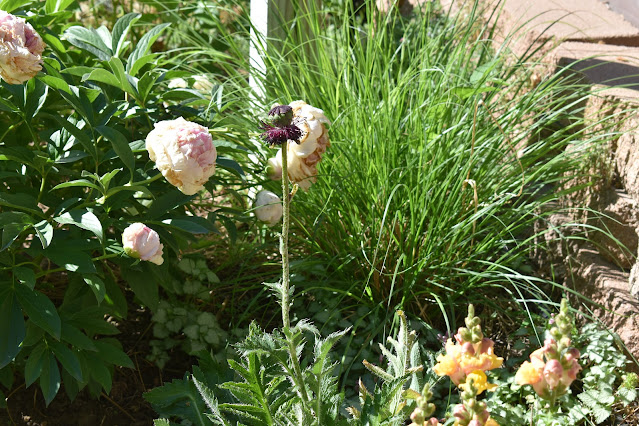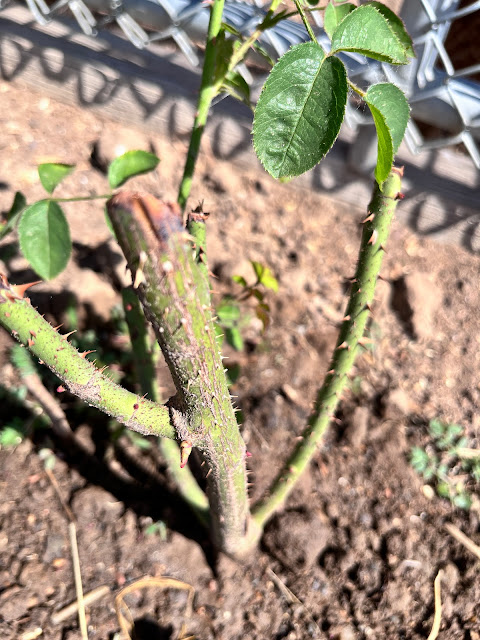The front garden right in the middle of the driveway, has been such an awkward space to work with. When we first moved here 13 years ago, the pine trees were toddles, barely 6 ft high. The previous owner had mulched the front half of it with river rock--mini boulders--not gravel. It had an underground water sprinkler system and even an underground electrical hook up to Christmas lighting. I thought: "What a wonderful garden spot." That first spring red tulips popped up and continued to do so every year until this year they didn't bloom because we had an unusually dry spring( just say the ugly word,
drought) Once the aspens and pine trees (truly Colorado natives) were large enough to provide shade, I began my plan to create a shade garden, adding more and more shade loving plants. Most of time I was able to keep the bind weed, wild morning glory, and thistle under control then last spring, a very wet one, we had an gave growth power to to both the desired and undesired plants in the center circle--actually tear shaped--was out of control. The bad guys--bind weed and morning glory-- took over on the shade side, covering everything, chocking out some of my favorites cultivars. The vinca crossed the path, filled the path, and combined with the wild morning glory to cover everything, creating a tangled mess of unwanted plant material.
On the sunny side of the trees, Canadian thistle took over and continues to be a huge problem, even after a lot of mitigation. One generation is killed, while the new generation pops up.
We began working on a plan to clean up the mess, but last year, but didn't follow through, hoping, I suppose, that Mother Nature would take pity and miraculously take care of the undesirable plants. The plan had been to use the push lawn mover to cut it all down, which the Head Gardener finally did last week. We had transplanted our favorite plants: hostas and bleeding heart earlier, along with some columbine and the knofphia. I so hated to dig them, but the were being choked out, making center circle redo necessary. My neighbor at the old house had given me a start of the beautiful orange and yellow spiked plants, and when we moved from that house here, many of my plants came with me, including my knophia.
We dug some of the Columbine, transplanting them, too. They have a huge main root, so hopefully they survive the move.

The path that I once created with the river rock had all but disappeared with spreading vinca that has taken over this garden. The Weed Eater made easy work of cleaning the path.

We tried pulling some of overgrowth just to make the chore easier for the mower.

I'm hoping to save the Malva plants had spread nicely, but the weeds had taken over. Once we cut back the bad stuff, I thinking that it can be irradiated and we can sod around the Malva, leaving it in place.
Canadian Thistle continue to plague this part of the garden. Hollyhocks replant themselves, by-passing the garden plan. The iris and Oaks registered day lilies that were moved from our previous garden 13 years ago, have been relocated the vegetable garden where they will be nurtured and perhaps replanted in other places. Now the weed mitigation continues. Soon the Head Gardener will get the rototiller in to work the soil and hopefully sod by summer's end.
Around The Garden
Just playing around with the camera, taking photos of the wet rocks around the pond as the lawn sprinkler splashes over the water, lily, and rocks.
I like wet rocks.
Plenty of critters in the garden last week, too.
Up close and personal, watching a lady bug chomp on a wild sunflower.
The imposing caterpillar feeds on the same sunflower along with several others. Once it has had it fill, it will begin its metamorphosis into a beautiful fritillary butterfly. I looked this little guy up on Youtube. You'll enjoy the video, too.
"Raising a Variegated Fritillary From a Caterpillar"
Unrelated, this little Taxiles Skipper has been hanging around the flowers in the garden bed around the back patio.

And the bees have been busy, too, raiding the hollyhock by the patio.
Gathering pollen is messy work.

It's common to see the Gold Finches feasting on the cone flowers in the fall after they have died back, but in summer? This was quite a lucky shot.
Poppies are late spring bloomers here, unless you plant them late then you get a surprise later on.

But the brilliant orange blossom does not last long and soon produces its
seed pod.
I love doing close up photos using my Nikon D3500 with the 70-300 telephoto lens. I don't have bend, stoop or put myself in compromising positions the might cause a fall to get a nice close up.
Even in the end of its cycle the poppy had a certain beauty. Who says purple and green don't go together?
Rose Update
So far no new growth on the rose transplanted from around the corner from the dark side of the house. In fact, this rose looks rather stressed.
But those three moved to the vegetable garden next to the hen pen are all showing signs of grown on the branches above the graft, meaning that the hybrid teas roses have been save--at least for the moment. So very exciting.
The vegetable garden looks amazing. We are eating lettuce from the garden now.
Finally the first wild sunflower shows a shy face.
Potpourri of Good Things:
Lucy and Mariah gearing up for county fair; a lost ladybug; Brody on squirrel duty, old, blind kitty, and a sweet baby's hand--the little blessings in life not to be taken for granted.
Have a fabulous week. I'll be joining
Angie For Mosaic Monday. See you there.


.jpeg)
.jpeg)
.jpeg)
.jpeg)
.jpeg)
.jpeg)
.jpeg)
.jpeg)
.jpeg)
.jpeg)
.jpeg)
.jpeg)

.jpeg)
.jpeg)
.jpeg)


.jpeg)

































